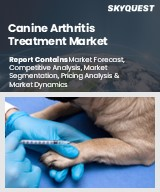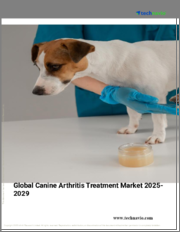
|
시장보고서
상품코드
1462685
개 관절염 치료 세계 시장 전망(-2030년) : 유형별, 치료 유형별, 투여 경로별, 유통 채널별, 지역별 분석Canine Arthritis Treatment Market Forecasts to 2030 - Global Analysis By Type, By Treatment Type, Route of Administration, Distribution Channel and By Geography |
||||||
세계의 개 관절염 치료제 시장 규모는 2023년 23억 달러로 예측 기간 중 CAGR 5.2%로 성장하여 2030년에는 32억 달러에 달할 것으로 예상됩니다. 개 관절염 치료는 관절염에 걸린 개의 통증과 염증을 관리하기 위한 다양한 접근법을 포함합니다.
비스테로이드성 항염증제(NSAIDs)와 같은 약물요법, 글루코사민이나 콘드로이틴과 같은 보충제, 물리치료, 체중 조절, 생활습관 개선 등이 있습니다. 심한 경우에는 수술이 필요할 수도 있습니다. 수술의 목적은 이동성을 개선하고 불편함을 줄이며 환자의 삶의 질을 향상시키는 것입니다.
미국 반려동물용품협회에 따르면 2017년 미국에는 약 9,420만 마리의 고양이와 8,970만 마리의 개가 가정에서 기르고 있습니다.
반려동물 입양의 증가와 반려동물 건강관리 지출 증가
세계 반려동물 입양의 증가 추세는 개 관절염 치료 시장의 성장에 크게 기여하고 있습니다. 더 많은 사람들이 반려동물을 가족의 필수 구성원으로 받아들이면서개 관절염과 같은 증상 치료를 포함한 반려동물 건강관리에 대한 지출이 증가하고 있습니다. 반려동물 보호자들은 반려동물의 건강과 웰빙을 보장하기 위해 첨단 의료 및 치료에 투자하려는 의지가 높아지고 있으며, 이는 혁신적인 치료법에 대한 수요를 촉진하고 개 관절염 치료의 전체 시장을 촉진하고 있습니다.
고급 치료 옵션에 따른 높은 비용
줄기세포 치료나 정형외과수술과 같은 고급 치료 옵션과 관련된 높은 비용은 반려견 관절염의 종합적인 치료를 원하는 반려동물 소유주에게 큰 경제적 장벽이 될 수 있습니다. 이러한 첨단 치료는 종종 많은 비용이 들기 때문에 환자가 치료를 받지 못할 수도 있습니다. 그 결과, 반려동물 보호자들은 더 저렴한 대안에 의존하거나 경제적 제약으로 인해 치료를 포기하는 경우가 있습니다. 이러한 가격 문제는 관절염으로 고통받는 반려동물을 위한 최적의 치료를 보장하기 위해 접근 가능하고 비용 효율적인 솔루션의 필요성을 강조하고 있습니다.
저침습적 치료 옵션에 대한 수요 증가
반려동물 보호자들은 점점 더 빠른 회복 시간을 제공하고 반려동물의 합병증 위험을 줄일 수 있는 최소침습적 시술을 원하고 있습니다. 관절경 검사 및 레이저 치료와 같은 최소침습적 기술은 그 효과와 반려동물의 생활 방식에 미치는 영향을 최소화할 수 있다는 점에서 인기를 끌고 있습니다. 이러한 추세는 동물병원과 제조업체들이 반려동물 보호자와 반려동물의 관절염에 대한 진화하는 요구를 충족시킬 수 있는 혁신적이고 최소침습적인 치료법을 개발하고 제공할 수 있는 기회를 제공합니다.
특정 치료법에 따른 잠재적 부작용 및 위험성
비스테로이드성 항염증제(NSAIDs)나 코르티코스테로이드와 같은 치료는 증상을 완화시킬 수 있지만, 위장 장애나 신장 합병증과 같은 부작용을 유발할 수 있습니다. 이러한 위험은 보호자가 이러한 치료법을 선택하는 것을 주저하게 만들고, 기존 치료법을 선택하려는 의지에 영향을 미칠 수 있습니다. 따라서 개 관절염 치료의 안전성과 유효성을 보장하는 것은 시장 수용과 반려동물의 복지에 대한 잠재적 위협을 줄이는 데 필수적입니다.
COVID-19의 영향 :
COVID-19는 반려동물의 의료 접근성과 반려동물 양육 행태를 변화시킴으로써 개 관절염 치료 시장에 영향을 미치고 있습니다. 불필요한 서비스에 대한 제한과 경제적 불확실성으로 인해 동물병원 방문이 줄어들어 진단과 치료에 영향을 미치고 있습니다. 또한 경제적 제약은 반려동물 보호자들의 고급 치료에 대한 투자 의지에 영향을 미쳐 시장 성장에 영향을 미치고 있으며, 합리적인 가격의 치료 옵션의 필요성을 강조하고 있습니다.
비스테로이드성 항염증제(NSAIDs) 부문은 예측 기간 중 최대 규모에 달할 것으로 예상됩니다.
애견 관절염 치료제 시장에서 비스테로이드성 항염증제(NSAIDs) 부문은 예측 기간 중 우위를 점할 것으로 예상됩니다. 이러한 우위는 반려견의 관절염 관련 통증과 염증을 관리하기 위한 전통적인 치료 옵션으로 널리 사용되는 것을 포함한 몇 가지 요인에 기인합니다. 또한 비스테로이드성 항염증제는 다른 고급 치료법에 비해 효과적이고 상대적으로 저렴하기 때문에 수의사들이 선호하는 경우가 많으며, 이는 시장에서의 우위를 점하는 데 기여하고 있습니다.
주사제 부문은 예측 기간 중 가장 높은 CAGR을 나타낼 것으로 예상됩니다.
애견 관절염 치료제 시장에서 주사제 부문은 예측 기간 중 가장 높은 성장률을 보일 것으로 예상됩니다. 이러한 성장은 투여의 편의성, 표적 치료의 효과, 혁신적인 주사 요법의 개발 등 여러 가지 요인에 기인합니다. 또한 제형 기술의 발전과 저침습적 치료로의 전환이 주사제 수요를 주도하고 있으며, 이는 빠른 성장을 기대할 수 있는 요인으로 작용하고 있습니다.
가장 큰 점유율을 차지하는 지역
예측 기간 중 북미가 개 관절염 치료 시장을 장악할 것으로 예상됩니다. 이는 가처분 소득이 높은 반려동물 소유자 인구가 많고, 수의학 인프라가 잘 갖추어져 있으며, 연구개발이 활발히 진행되고 있기 때문입니다. 또한 반려동물의 건강에 대한 인식이 높아지고 반려동물을 인간과 동일하게 취급하는 경향이 이 지역의 번영에 더욱 기여하고 있습니다. 그 결과, 북미는 당분간 개 관절염 치료 시장에서 주도적인 위치를 유지할 것으로 예상됩니다.
CAGR이 가장 높은 지역 :
아시아태평양은 예측 기간 중 개 관절염 치료 시장에서 급성장할 것으로 예상됩니다. 이는 반려동물 보유율 증가, 가처분 소득 증가, 반려동물 건강관리에 대한 인식이 높아지면서 관절염 치료제에 대한 수요가 증가하고 있기 때문입니다. 또한 수의학 인프라의 개선과 첨단 치료법의 채택으로 치료 접근성이 향상되고 있습니다. 그 결과, 아시아태평양은 시장 확대, 투자 유치, 개 관절염 치료 솔루션의 기술 혁신을 촉진할 수 있는 중요한 기회를 제공합니다.
무료 커스터마이징 서비스
이 보고서를 구독하는 고객은 다음과 같은 무료 맞춤화 옵션 중 하나를 사용할 수 있습니다. :
- 기업 개요
- 추가 시장 기업 종합 프로파일링(최대 3개사)
- 주요 기업의 SWOT 분석(최대 3개사)
- 지역 세분화
- 고객의 관심에 따른 주요 국가별 시장 추정치, 예측, CAGR(주: 타당성 확인에 따라 다름)
- 경쟁사 벤치마킹
- 제품 포트폴리오, 지역적 입지, 전략적 제휴를 기반으로 한 주요 기업 벤치마킹
목차
제1장 주요 요약
제2장 서문
- 개요
- 이해관계자
- 조사 범위
- 조사 방법
- 데이터 마이닝
- 데이터 분석
- 데이터 검증
- 조사 어프로치
- 조사 정보원
- 1차 조사 정보원
- 2차 조사 정보원
- 전제조건
제3장 시장 동향 분석
- 촉진요인
- 억제요인
- 기회
- 위협
- 신흥 시장
- COVID-19의 영향
제4장 Porter's Five Forces 분석
- 공급 기업의 교섭력
- 구매자의 교섭력
- 대체품의 위협
- 신규 진출업체의 위협
- 경쟁 기업간 경쟁 관계
제5장 세계의 개 관절염 치료 시장 : 유형별
- 골관절염
- 류마티스 관절염
- 소아특발성관절염
제6장 세계의 개 관절염 치료 시장 : 치료 유형별
- 비스테로이드성항염증약(NSAID)
- 질환 조절성 항류마티스약(DMARD)
- 코르티코스테로이드
- 뉴트라슈티컬
- 물리치료와 재활
- 줄기세포 요법
- 수술
- 기타 치료 유형
제7장 세계의 개 관절염 치료 시장 : 투여 경로별
- 경구
- 주사제
- 국소
제8장 세계의 개 관절염 치료 시장 : 유통 채널별
- 동물 클리닉·병원
- 소매 약국
- 온라인 약국
제9장 세계의 개 관절염 치료 시장 : 지역별
- 북미
- 미국
- 캐나다
- 멕시코
- 유럽
- 독일
- 영국
- 이탈리아
- 프랑스
- 스페인
- 기타 유럽
- 아시아태평양
- 일본
- 중국
- 인도
- 호주
- 뉴질랜드
- 한국
- 기타 아시아태평양
- 남미
- 아르헨티나
- 브라질
- 칠레
- 기타 남미
- 중동 및 아프리카
- 사우디아라비아
- 아랍에미리트
- 카타르
- 남아프리카공화국
- 기타 중동 및 아프리카
제10장 주요 발전
- 협정, 파트너십, 협업, 합병사업
- 인수합병
- 신제품 발매
- 사업 확대
- 기타 주요 전략
제11장 기업 개요링
- Boehringer Ingelheim Animal Health
- Ceva Sante Animale
- Dechra Pharmaceuticals PLC
- Elanco Animal Health
- Hill's Pet Nutrition
- InVivo Therapeutics Corporation
- Mars Petcare
- Merck Animal Health
- Norbrook Laboratories
- Nutramax Laboratories, Inc.
- OrthoPets LLC
- Rejuvenate Bio
- Royal Canin
- Veterinary Orthopedic Implants Inc.
- Vetoquinol S.A.
- Virbac
- Zoetis Inc.
According to Stratistics MRC, the Global Canine Arthritis Treatment Market is accounted for $2.3 billion in 2023 and is expected to reach $3.2 billion by 2030 growing at a CAGR of 5.2% during the forecast period. Canine arthritis treatment involves various approaches to managing pain and inflammation in dogs affected by arthritis. These may include medication such as nonsteroidal anti-inflammatory drugs (NSAIDs), supplements like glucosamine and chondroitin, physical therapy, weight management, and lifestyle modifications. In severe cases, surgery may be necessary. The goal is to improve mobility, reduce discomfort, and enhance the quality of life for affected dogs.
According to the American Pet Products Association, an estimated 94.2 million cats and 89.7 million dogs are owned by households in the U.S. during 2017.
Market Dynamics:
Driver:
Rising pet ownership and expenditure on pet healthcare
The increasing trend of pet ownership worldwide has significantly contributed to the growth of the canine arthritis treatment market. As more people embrace pets as integral members of their families, there's a corresponding rise in expenditure on pet healthcare, including treatment for conditions like canine arthritis. Pet owners are increasingly willing to invest in advanced medical care and therapies to ensure the health and well-being of their furry companions, driving demand for innovative treatments and boosting the overall market for canine arthritis treatment.
Restraint:
High cost associated with advanced treatment options
The high cost associated with advanced treatment options, such as stem cell therapy and orthopedic surgeries, presents a significant financial barrier for pet owners seeking comprehensive care for canine arthritis. These advanced treatments often entail substantial expenses, potentially deterring individuals from pursuing them. Consequently, pet owners may resort to less expensive alternatives or even forego treatment altogether due to financial constraints. This affordability challenge underscores the need for accessible and cost-effective solutions to ensure optimal care for pets suffering from arthritis.
Opportunity:
Growing demand for minimally invasive treatment options
Pet owners are increasingly seeking less invasive procedures that offer quicker recovery times and reduce the risk of complications for their furry companions. Minimally invasive techniques, such as arthroscopy and laser therapy, are gaining popularity due to their efficacy and minimal disruption to the pet's lifestyle. This trend presents an opportunity for veterinary clinics and manufacturers to develop and offer innovative, minimally invasive treatments to meet the evolving needs of pet owners and their arthritic pets.
Threat:
Potential side effects and risks associated with certain treatment modalities
Treatments like non-steroidal anti-inflammatory drugs (NSAIDs) or corticosteroids can alleviate symptoms, but they may also lead to adverse reactions such as gastrointestinal issues or renal complications. Such risks may deter pet owners from pursuing these treatments, impacting their willingness to opt for conventional therapies. Consequently, ensuring the safety and efficacy of canine arthritis treatments is essential to mitigating potential threats to market acceptance and pet well-being.
Covid-19 Impact:
The COVID-19 pandemic has influenced the canine arthritis treatment market by altering veterinary care access and pet ownership behaviors. Restrictions on non-essential services and economic uncertainties have led to decreased veterinary visits, affecting diagnosis and treatment. Additionally, financial constraints have influenced pet owners' willingness to invest in advanced treatments, impacting market growth and emphasizing the need for affordable care options.
The nonsteroidal anti-inflammatory drugs (NSAIDs) segment is expected to be the largest during the forecast period
In the canine arthritis treatment market, the nonsteroidal anti-inflammatory drugs (NSAIDs) segment is projected to dominate during the forecast period. This dominance can be attributed to several factors, including their widespread use as a conventional treatment option for managing arthritis-related pain and inflammation in dogs. Additionally, NSAIDs are often preferred by veterinarians due to their efficacy and relatively low cost compared to other advanced treatment modalities, contributing to their anticipated prominence in the market.
The injectables segment is expected to have the highest CAGR during the forecast period
In the canine arthritis treatment market, the injectables segment is projected to experience the highest growth during the forecast period. This growth is attributed to several factors, including the convenience of administration, efficacy in delivering targeted treatment, and the development of innovative injectable therapies. Additionally, advancements in formulation technologies and a shift towards minimally invasive treatment options are driving the demand for injectables, contributing to their anticipated rapid growth trajectory.
Region with largest share:
Over the forecast period, North America is poised to dominate the canine arthritis treatment market. This is due to a large population of pet owners with high disposable income, a well-established veterinary healthcare infrastructure, and advanced research and development activities. Additionally, increasing awareness about pet health and a growing trend towards the humanization of pets further contribute to the region's prominence. Consequently, North America is expected to maintain its leading position in the canine arthritis treatment market in the foreseeable future.
Region with highest CAGR:
Over the forecast period, the Asia Pacific region is poised for rapid growth in the canine arthritis treatment market. This is due to increasing pet ownership rates, rising disposable incomes, and growing awareness of pet healthcare, which are driving demand for arthritis treatments. Additionally, improving veterinary infrastructure and the adoption of advanced treatment modalities are enhancing accessibility to care. As a result, the Asia-Pacific region presents significant opportunities for market expansion, attracting investments, and fostering innovation in canine arthritis treatment solutions.
Key players in the market
Some of the key players in Canine Arthritis Treatment Market include Boehringer Ingelheim Animal Health, Ceva Sante Animale, Dechra Pharmaceuticals PLC, Elanco Animal Health, Hill's Pet Nutrition, InVivo Therapeutics Corporation, Mars Petcare, Merck Animal Health, Norbrook Laboratories, Nutramax Laboratories, Inc., OrthoPets LLC, Rejuvenate Bio, Royal Canin, Veterinary Orthopedic Implants Inc., Vetoquinol S.A., Virbac and Zoetis Inc.
Key Developments:
In February 2024, Rejuvenate Bio partnered with a leading animal health company to develop and commercialize groundbreaking gene therapy for canine osteoarthritis, aiming to address the condition's widespread prevalence and devastating consequences, potentially revolutionizing dog health. This agreement with the global company follows the agreement reached in 2022 with Phibro Animal Health and further validates the gene therapy technology developed by Rejuvenate Bio and their strategy to develop their breakthrough technology in both animal health and human health.
In May 2023, The Food and Drug Administration (FDA) approved Librela, for the control of canine OA pain in the U.S. The first and only injectable monoclonal antibody (mAb) treatment for canine OA is expected to be available in late 2023. A once-monthly injection administered by a veterinary professional, Librela (bedinvetmab injection) works differently than other pain medications, according to a May 5 release from Zoetis.
Types Covered:
- Osteoarthritis
- Rheumatoid Arthritis
- Juvenile Idiopathic Arthritis
Treatment Types Covered:
- Nonsteroidal Anti-Inflammatory Drugs (NSAIDs)
- Disease-Modifying Antirheumatic Drugs (DMARDs)
- Corticosteroids
- Nutraceuticals
- Physical Therapy and Rehabilitation
- Stem Cell Therapy
- Surgery
- Other Treatment Types
Route of Administrations Covered:
- Oral
- Injectables
- Topical
Distribution Channels Covered:
- Veterinary Clinics and Hospitals
- Retail Pharmacies
- Online Pharmacies
Regions Covered:
- North America
- US
- Canada
- Mexico
- Europe
- Germany
- UK
- Italy
- France
- Spain
- Rest of Europe
- Asia Pacific
- Japan
- China
- India
- Australia
- New Zealand
- South Korea
- Rest of Asia Pacific
- South America
- Argentina
- Brazil
- Chile
- Rest of South America
- Middle East & Africa
- Saudi Arabia
- UAE
- Qatar
- South Africa
- Rest of Middle East & Africa
What our report offers:
- Market share assessments for the regional and country-level segments
- Strategic recommendations for the new entrants
- Covers Market data for the years 2021, 2022, 2023, 2026, and 2030
- Market Trends (Drivers, Constraints, Opportunities, Threats, Challenges, Investment Opportunities, and recommendations)
- Strategic recommendations in key business segments based on the market estimations
- Competitive landscaping mapping the key common trends
- Company profiling with detailed strategies, financials, and recent developments
- Supply chain trends mapping the latest technological advancements
Free Customization Offerings:
All the customers of this report will be entitled to receive one of the following free customization options:
- Company Profiling
- Comprehensive profiling of additional market players (up to 3)
- SWOT Analysis of key players (up to 3)
- Regional Segmentation
- Market estimations, Forecasts and CAGR of any prominent country as per the client's interest (Note: Depends on feasibility check)
- Competitive Benchmarking
- Benchmarking of key players based on product portfolio, geographical presence, and strategic alliances
Table of Contents
1 Executive Summary
2 Preface
- 2.1 Abstract
- 2.2 Stake Holders
- 2.3 Research Scope
- 2.4 Research Methodology
- 2.4.1 Data Mining
- 2.4.2 Data Analysis
- 2.4.3 Data Validation
- 2.4.4 Research Approach
- 2.5 Research Sources
- 2.5.1 Primary Research Sources
- 2.5.2 Secondary Research Sources
- 2.5.3 Assumptions
3 Market Trend Analysis
- 3.1 Introduction
- 3.2 Drivers
- 3.3 Restraints
- 3.4 Opportunities
- 3.5 Threats
- 3.6 Emerging Markets
- 3.7 Impact of Covid-19
4 Porters Five Force Analysis
- 4.1 Bargaining power of suppliers
- 4.2 Bargaining power of buyers
- 4.3 Threat of substitutes
- 4.4 Threat of new entrants
- 4.5 Competitive rivalry
5 Global Canine Arthritis Treatment Market, By Type
- 5.1 Introduction
- 5.2 Osteoarthritis
- 5.3 Rheumatoid Arthritis
- 5.4 Juvenile Idiopathic Arthritis
6 Global Canine Arthritis Treatment Market, By Treatment Type
- 6.1 Introduction
- 6.2 Nonsteroidal Anti-Inflammatory Drugs (NSAIDs)
- 6.3 Disease-Modifying Antirheumatic Drugs (DMARDs)
- 6.4 Corticosteroids
- 6.5 Nutraceuticals
- 6.5.1 " Glucosamine
"
- 6.5.2 Chondroitin
- 6.6 Physical Therapy and Rehabilitation
- 6.7 Stem Cell Therapy
- 6.8 Surgery
- 6.9 Other Treatment Types
7 Global Canine Arthritis Treatment Market, By Route of Administration
- 7.1 Introduction
- 7.2 Oral
- 7.3 Injectables
- 7.4 Topical
8 Global Canine Arthritis Treatment Market, By Distribution Channel
- 8.1 Introduction
- 8.2 Veterinary Clinics and Hospitals
- 8.3 Retail Pharmacies
- 8.4 Online Pharmacies
9 Global Canine Arthritis Treatment Market, By Geography
- 9.1 Introduction
- 9.2 North America
- 9.2.1 US
- 9.2.2 Canada
- 9.2.3 Mexico
- 9.3 Europe
- 9.3.1 Germany
- 9.3.2 UK
- 9.3.3 Italy
- 9.3.4 France
- 9.3.5 Spain
- 9.3.6 Rest of Europe
- 9.4 Asia Pacific
- 9.4.1 Japan
- 9.4.2 China
- 9.4.3 India
- 9.4.4 Australia
- 9.4.5 New Zealand
- 9.4.6 South Korea
- 9.4.7 Rest of Asia Pacific
- 9.5 South America
- 9.5.1 Argentina
- 9.5.2 Brazil
- 9.5.3 Chile
- 9.5.4 Rest of South America
- 9.6 Middle East & Africa
- 9.6.1 Saudi Arabia
- 9.6.2 UAE
- 9.6.3 Qatar
- 9.6.4 South Africa
- 9.6.5 Rest of Middle East & Africa
10 Key Developments
- 10.1 Agreements, Partnerships, Collaborations and Joint Ventures
- 10.2 Acquisitions & Mergers
- 10.3 New Product Launch
- 10.4 Expansions
- 10.5 Other Key Strategies
11 Company Profiling
- 11.1 Boehringer Ingelheim Animal Health
- 11.2 Ceva Sante Animale
- 11.3 Dechra Pharmaceuticals PLC
- 11.4 Elanco Animal Health
- 11.5 Hill's Pet Nutrition
- 11.6 InVivo Therapeutics Corporation
- 11.7 Mars Petcare
- 11.8 Merck Animal Health
- 11.9 Norbrook Laboratories
- 11.10 Nutramax Laboratories, Inc.
- 11.11 OrthoPets LLC
- 11.12 Rejuvenate Bio
- 11.13 Royal Canin
- 11.14 Veterinary Orthopedic Implants Inc.
- 11.15 Vetoquinol S.A.
- 11.16 Virbac
- 11.17 Zoetis Inc.
















